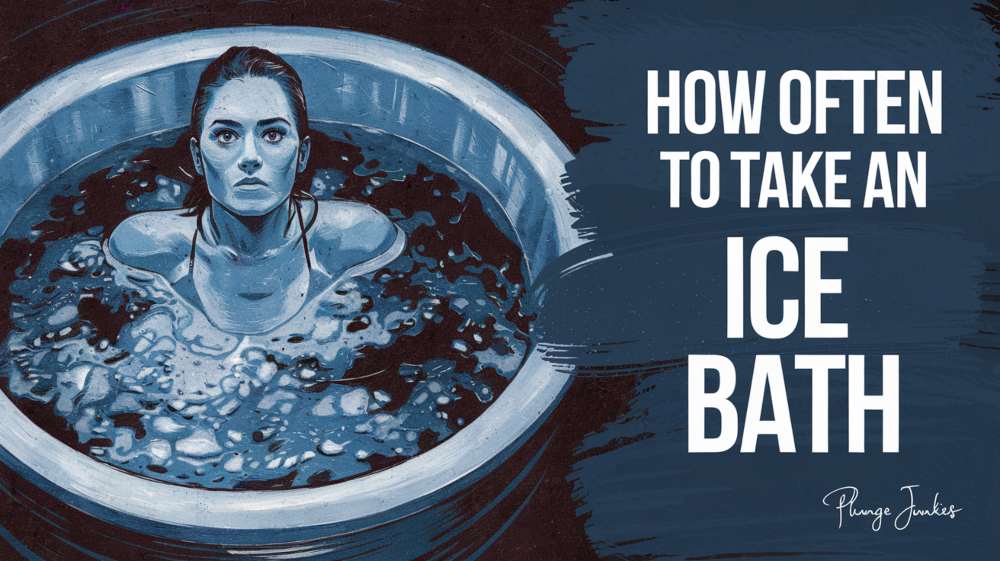With the promise of certain health-boosting benefits, people are submerging in an ice bath, plunging a cold plunge, or even dipping in icy lakes. These forms of cold water therapy are becoming a very popular addition to many peoples’ normal health routine. But how often should you take an ice bath, and how does frequency affect the benefits?
You can ice bath daily, or multiple times a week to experience the benefits. How many ice baths a person should take a week, depends on your individual goals. A common goal is working your way up to 2-3 ice baths a week at op to 5-10 minutes per session depending on the temperature.
To help you find a clear answer for how often you should practice cold water therapy, we will examine the benefits and research on the best frequency. Examining the effects more or less ice baths have on these benefits can help you set your personal goals with safety in mind
How Many Times a Week Should I Cold Plunge?

When deciding how many ice baths you want to take a week, you need to ask yourself what your goals are, what kind of excercises you do, and what you are primarily hoping to get from an ice bath. Let’s look the things to consider, based on your activity, when trying to decide how often to ice bath.
For Mental Benefits
If you’re primarily interested in the mental health benefits of ice baths, such as stress reduction, mood improvement, and increased mental resilience, you can incorporate them into your routine quite frequently.
Frequency: 3-7 times per week for 3-10 minutes per session
If you’re primarily interested in the mental health benefits of ice baths, such as stress reduction, mood improvement, and increased mental resilience, you can incorporate them into your routine quite frequently.
The mental benefits of ice baths can be significant, even for those who aren’t particularly physically active. Cold exposure has been shown [1] to stimulate the release of endorphins and norepinephrine, which can boost mood and increase alertness. Regular ice baths may also help improve your ability to handle stress and discomfort in other areas of life.
When Strength Training for Muscle Growth
For those focused on strength training and muscle growth, the approach to ice baths should be more measured. While ice baths can be beneficial for recovery, they should be used strategically when your goal is muscle hypertrophy. Too frequent use of ice baths might interfere with the inflammation process necessary for muscle growth.
Frequency: 1-3 times per week Duration: up to 10 minutes per session
Balance ice bath use with your muscle growth goals. Some studies [2] suggest that regular cold water immersion might slightly reduce long-term strength gains. Too frequent use of ice baths might interfere with the inflammation process necessary for muscle growth.
Avoid ice baths before strength training sessions, as the cold can temporarily reduce muscle performance. Instead, focus on using ice baths after your most intense workouts or on days when you’ve trained major muscle groups.
Delayed Onset Muscle Soreness (DOMS) is a common affliction for athletes, or those who regularly workout. Research [3] has shown that ice baths can significantly reduce muscle soreness post a high-intensity workout.
For Runners or Mostly Cardio Exercisers
Endurance athletes can often benefit from more frequent use of ice baths due to the high-volume, repetitive nature of their training.
Frequency: 3-4 times per week for up to 10 minutes per session
For runners, cyclists, swimmers, and other endurance athletes, ice baths can be a crucial part of the recovery process, helping to manage the cumulative fatigue that comes with consistent training. The cold exposure helps numb the nerve endings, offering immediate pain relief and reducing the perception of soreness.
For endurance athletes, ice baths can be a crucial part of the recovery process, helping to manage the cumulative fatigue that comes with consistent training. The benefits include faster recovery from endurance activities, reduced inflammation and muscle damage, and potential improvement in subsequent performance. Use ice baths after particularly challenging workouts or races, and consider them especially beneficial during heavy training periods or when you’re increasing your mileage.
This frequency is also great when you pair exercise and ice baths for weight loss goals. Some research [4] suggests that cold temperatures can activate brown fat in the body, which plays a role in burning calories. The activation of brown fat stimulates thermogenesis – a process where the body burns calories to generate heat.
For more info on how ice baths may help with weight loss, see our article how ice baths help burn fat.
For Immune System Boost
If you’re looking to enhance your immune system through cold water therapy, incorporating regular ice baths into your routine can be beneficial. Cold water immersion has been shown to stimulate the production and activity of white blood cells, which are crucial components of the immune system.
Frequency: 2-3 times per week for 5-10 minutes per session
The controlled stress of an ice bath can trigger a hermetic response, where your body adapts to become more resilient. This process can lead to improved overall immune function over time. Regular exposure to cold water can boost the white blood cell count because the body is forced to react to changing conditions. Over time, the body becomes better at mobilizing its defenses.
Try to space out your sessions evenly throughout the week to maintain a steady level of cold exposure. Studies have shown that cold water therapy can indeed activate the immune system [5], with one study demonstrating that participants who engaged in cold water immersion three times a week for six weeks experienced noticeable activation of their immune system.
How Often To Ice Bath for Beginners

Embarking on the journey of ice bath therapy requires a thoughtful and measured approach, especially for beginners. Before starting, it’s essential to understand what ice baths entail. This knowledge will help set realistic expectations and make informed decisions about how to incorporate ice baths into your routine.
1. Check Water Temperature
Before getting in, always check the water temperature. See the guidelines for for how cold an ice bath should be. Colder water means you should stay in for shorter periods. A thermometer can help you keep track and stay safe.
2. Start With Short Initial Sessions
Begin with short immersions, lasting no more than a few minutes. As your body gets accustomed to the cold, you can slowly increase the duration of each session. It’s crucial not to rush this process.
3. Monitor Body’s Response
After each session, observe how your body reacts. Look out for signs of positive adaptation like feeling invigorated or having improved recovery after physical activity. Be aware of any negative responses such as excessive shivering, discomfort, or skin irritation.
4. Gradual Frequency Increase
Start with one session per week. Once comfortable, consider adding another session, but only if your body’s response is consistently positive. Remember, the goal is to enhance wellness, not to push your limits unnecessarily.
5. Focus on Breathing
Breathing plays a crucial role in managing the body’s response to cold. Practice deep, controlled breathing to help calm the mind and regulate body temperature. This technique will be invaluable during and after the ice bath.
6. Stay Hydrated
Ensure you are well-hydrated before taking an ice bath. Proper hydration aids in circulation and helps the body regulate temperature more effectively.
7. Use a Timer
To avoid overstaying in the cold water, especially as a beginner, use a timer. This will help you keep track of time and ensure that you don’t exceed the recommended initial duration.
8. Have a Plan for After
Plan how you will warm up after the ice bath. Gentle activities like stretching, wearing warm clothing, or drinking a warm beverage can aid in the recovery process.
See what to do after an ice bath for safety tips and ideas for expanding your cold therapy routine.
Risks of Frequent Cold Plunging or Ice baths

While ice baths can offer numerous benefits, it’s crucial to be aware of the potential risks associated with their frequent use. Following basic temperature and frequency guidelines can help greatly reduce basic risk of frequent cold exposure.
Some health issues that could make ice baths risky include:
- High blood pressure or heart problems
- Poor blood flow in arms or legs
- Being extra sensitive to cold
- Having open cuts or sores
- Diabetes
Cold water can be hard on your heart. It might even cause heart problems if you already have heart issues. That’s why doctors say to avoid ice baths if you’ve had heart trouble before.
Other possible risks of ice baths are:
- Getting too cold: If you stay in too long, your body temperature could drop to dangerous levels
- Frostbite: Your fingers, toes, or other body parts might get too cold and get damaged
- Skin problems: Some people might get itchy, red, or bumpy skin
To stay safe, follow the recommended durations for ice baths. If you understand these risks and are careful, you can enjoy ice baths safely. Just remember to be cautious and respect what your body is telling you.
Final Thoughts
Ice baths and cold water therapy are different for everyone. They depend on what you want to achieve, how you live, and how fit you are. Whether you’re an athlete trying to recover faster or just someone looking to feel better overall, how often you take ice baths should be based on what works for you.
Everyone’s cold therapy journey is unique. How you use it in your life is a personal choice. Athletes might focus on recovery and doing better in their sport, making ice baths a regular part of their tough training schedules. On the other hand, people looking for general wellness might be more interested in the mental benefits, like feeling clearer and handling stress better. They might fit ice baths into their daily routines in a way that feels comfortable to them.
It’s not about following a strict schedule or copying what others do. Instead, it’s about finding a pattern that works for your body and lifestyle. This process is about taking care of your body and mind. Let your body’s natural strength and ability to adapt guide you in deciding how often and how intense your ice baths should be. Remember, the goal is to push yourself a bit, but not too far.
References
- Yankouskaya, A., Williamson, R., Stacey, C., Totman, J. J., & Massey, H. (2023). Short-Term Head-Out Whole-Body Cold-Water Immersion Facilitates Positive Affect and Increases Interaction between Large-Scale Brain Networks. Biology, 12(2), 211. https://doi.org/10.3390/biology12020211
- Roberts, L. A., Raastad, T., Markworth, J. F., Figueiredo, V. C., Egner, I. M., Shield, A., Cameron-Smith, D., Coombes, J. S., & Peake, J. M. (2015). Post-exercise cold water immersion attenuates acute anabolic signalling and long-term adaptations in muscle to strength training. The Journal of physiology, 593(18), 4285–4301. https://doi.org/10.1113/JP270570
- Wang, Y., Li, S., Zhang, Y., Chen, Y., Yan, F., Han, L., & Ma, Y. (2021). Heat and cold therapy reduce pain in patients with delayed onset muscle soreness: A systematic review and meta-analysis of 32 randomized controlled trials. Physical Therapy in Sport, 48, 177-187. https://doi.org/10.1016/j.ptsp.2021.01.004
- Huo, C., Song, Z., Yin, J., Zhu, Y., Miao, X., Qian, H., Wang, J., Ye, L., & Zhou, L. (2022). Effect of Acute Cold Exposure on Energy Metabolism and Activity of Brown Adipose Tissue in Humans: A Systematic Review and Meta-Analysis. Frontiers in physiology, 13, 917084. https://doi.org/10.3389/fphys.2022.917084
- Janský, L., Pospísilová, D., Honzová, S., Ulicný, B., Srámek, P., Zeman, V., & Kamínková, J. (1996). Immune system of cold-exposed and cold-adapted humans. European journal of applied physiology and occupational physiology, 72(5-6), 445–450. https://doi.org/10.1007/BF00242274




















